Samsung Galaxy Nexus & Ice Cream Sandwich Review
by Brian Klug & Anand Lal Shimpi on January 18, 2012 1:34 PM ESTThe UI: Holo Evolved
When I first met Holo, Google's Honeycomb theme, I wasn't convinced that it was something that would last. It was different, which earned Google points for sure, but it wasn't exactly comfortable. I was surprised to see an evolution of Holo used in ICS, but the theme has grown on me.
Ice Cream Sandwich feels a lot like Android meets Windows Phone. Part of that surely has to do with the very contrasty nature of the theme, but it's also the choice of font (Android 4.0 replaces Droid Sans with Roboto) and hard edges sprinkled throughout the UI. Holo is still distinctly Android in that there are still multiple home screens with support for widgets, but it's also different. Ice Cream Sandwich is Android maturing, it's the second implementation of Holo allowing us to finally plot a trajectory for where Google sees this thing going in the near term. It's different as I mentioned before. Holo and ICS aren't iOS nor does it look like they ever will be. The UI is either going to pull you in or turn you off. I like it. It's different, it's clearly a play on the whole Android theme; it's the type of UI you'd expect from an OS named after a robot.

Droid Sans v. Roboto (ICS)
At the same time it's no longer awkward. Elements of the design and many of the first party apps are just clean. It's truly a first class citizen. Different than both iOS and Windows Phone, but with a design that's just as credible.
The core of Android remains unchanged. You get multiple home screens (five by default) that you can populate with shortcuts, widgets or folders. Widgets are resizable just as they were in Honeycomb. Shortcuts work the same way they always have, while Folders get a nice update in ICS. Drag any icon on top of another one and they'll create a folder. Folders are quick to open and easy to rename, just tap on the name of any open folder and type away.
The app launcher gets a bit of a facelift. Instead of an endless scrolling cube, you get pages of apps that you flip through. Once you've reached the end of your pages of apps you'll start flipping through widgets. All of this is smoother than it has ever been on Android.
| Gingerbread vs. Ice Cream Sandwich | ||||
| Gingerbread | Ice Cream Sandwich | |||
| Lock |
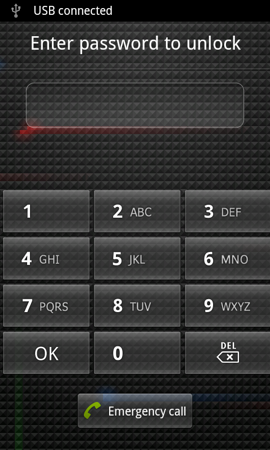 |
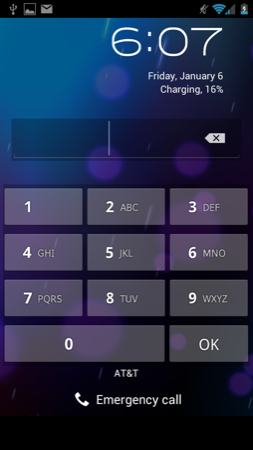 |
||
| Home |
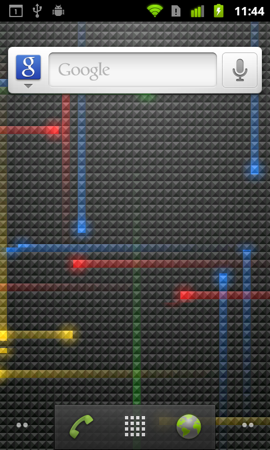 |
 |
||
| Launcher |
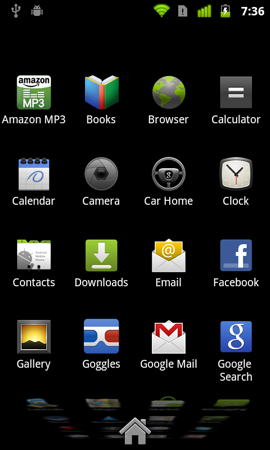 |
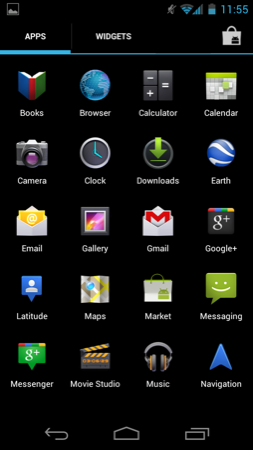 |
||
The New Contextual Menu Button
Play around with ICS for a little bit and you'll quickly pick up on a new UI element that appears inspired by Windows Phone:
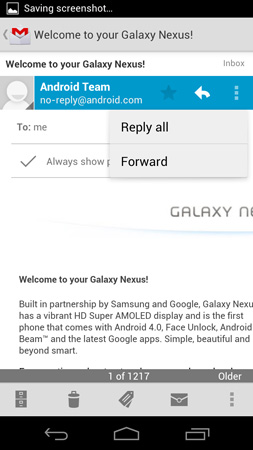
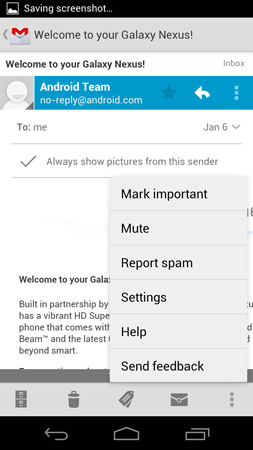
These vertically oriented ellipses will appear at either the top or bottom of an app and reveal additional menu options.
In Gingerbread you had the fixed Android menu button, but with that gone you have to rely on these contextual menu buttons to bring up additional actions. I'm honestly pleased with the move because all too often I'd forget to tap the menu button to see whether or not there were additional options in Gingerbread. ICS makes it very obvious when there's more you can do.
The Task Switcher
A cornerstone of any good operating system is a good task switcher. I still believe that webOS dealt with the concept of individual apps and switching between them better than any other mobile OS, but it looks like that platform is pretty much dead with little chance of making it into the top three mobile OSes.
Google and iOS haven't traditionally focused much on task switching, although both have provided support for it. In Gingerbread, you'd switch between apps by holding down the home button, which brought up a list of up to eight of your most recently used apps. Ice Cream Sandwich implements a drawer-style app switcher menu, first introduced in Honeycomb, activated by hitting the dedicated task switcher button:
| Gingerbread vs. Ice Cream Sandwich | ||||
| Gingerbread | Ice Cream Sandwich | |||
| Task Switcher |
 |
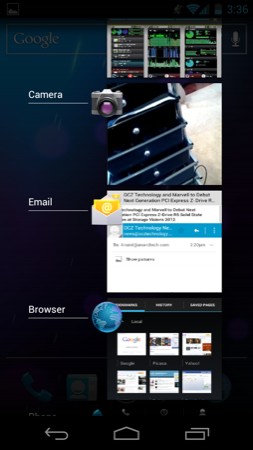 |
||
The Gingerbread method of switching may be quicker, but it's definitely not as useful as what ICS offers. For starters you can switch between more than just six apps in ICS. The most recent apps are located at the bottom of the list, the oldest at the top. You can also quit apps using the switcher by sliding them to the left or right. Doing so immediately frees up any memory the app was using, even if it was suspended.
Scrolling through the list of recent apps, like scrolling pretty much anywhere in ICS, is extremely smooth. The only real complaint I have here is that the task switcher takes far too long to draw initially. As I alluded to before, this is something that may get better with a faster SoC, particularly one with a faster GPU.
The Shade & Notifications
Notifications in ICS are still handled via the status bar at the very top of the screen and a pull down notification shade. The shade in ICS is partially transparent by default and once again, very smoothly animated. The network carrier string is included at the bottom of the shade rather than in the status bar at the top. You can clear notifications individually or hit the X to clear all of them.
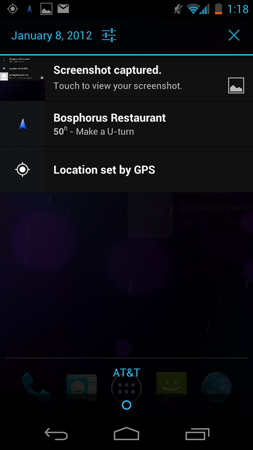
I am surprised Google didn't borrow the quick settings options its partners usually like to stick in the shade, but there is a link to the system settings panel at the top.
Screenshots
Android 4.x also finally enables the ability to take screenshots from within the OS. There's no necessity for OEMs to bake-in their own screenshot functionality and key press combination, no need to connect using USB and fire up ddms, and no need to root and install some application to make it work. Traditionally, those three have been the exclusive way to get screenshots taken on Android.
To take a screenshot in Android 4.x, simply hold volume down and the power/lock button at the same time. An animation plays, you get a notification, and the screenshot is saved (with a timestamped name in PNG format) in /pictures/screenshots as shown above.
I can't emphasize enough how important being able to take screenshots is for a platform in general. Without screenshots, users can only vicariously share a given OS when they're in direct contact with someone else. Being able to take screenshots without all the nonsense I've outlined above is part of what has made iOS so ubiquitous online - browse Reddit and count how many screenshots of SMS conversations (trite as they all are) are clearly from iOS versus Android. It's clear to me that Matias Duarte understands this, since webOS and even the Danger Hiptop since day 1 had the ability to take screenshots. Now Android 4.x finally joins the fray.










185 Comments
View All Comments
HooDooMagic - Friday, January 20, 2012 - link
I think it's already been mentioned that 4.03 fixed the task switcher lag. I have alpha ICS 4.03 roms running on a Nexus One, Nook Color and Samsung Galaxy Tab 10.1 and everything runs very smoothly on all 3 devices. Even the very underpowered Nook has surprisingly little lag and stutter when using the task switcher and transitioning between screens/app drawer etc.Chloiber - Wednesday, January 18, 2012 - link
The Galaxy Nexus is a very nice phone indeed, but there are just some things that I don't like about it. As mentioned in the review, the GPU is not the best, which is actually the main reason I won't buy the phone. I buy smartphones which should last about 2 years. Buying one with a GPU from the beginning of last year is just not good enough. As Anand mentions: better wait for Q2, maybe Q3. At the moment, the GN is certainly the best phone (in my opinion) money can buy, but it's not the right moment to buy an android phone.The review is very late indeed...but very thorough - thank you!
One question remains: are microSD slots a thing of the past? Google mentioned that there is a good reason why they didn't include one (slow speeds for apps). But I still think that's a very bad reason not to include a slot. While it is true, that the mSD cards are pretty slow compared to internal storage, there is just no way in hell I'm gonna pay 100$+ for 16GB of additional internal NAND. Additionally, you don't need high speeds for music, pictures and movies (the main reason to get an SD card).
I hope for a phone in Q2/Q3 with a) better SoC, b) an SD card slot and c) a 720p IPS or SAMOLED+ screen.
humancyborg - Wednesday, January 18, 2012 - link
I agree. The GPU is a terrible oversight on this phone, particularly considering the inclusion (finally) of OpenGL rendering throughout Android.With the 4S GPU being 3-4x faster it's tough to see how this phone is going to stand the test of time. Presumably the iPad3 and next iPhone will be packing an even more powerful SoC and GPU.
This is one of the main reasons that I think Apple is in a great position going forward with regards to hardware. With the exception of Samsung, everyone else is relying on TI, Qualcomm, Intel, etc to make the right decisions with regards to CPU/GPU etc combination and clearly those chip makers do not always have the best insight with regards to product pipeline or requirements.
A retina display-ish version of the iPad is going to take a GPU far beyond anything the current SoC guys are manufacturing.
tipoo - Wednesday, January 18, 2012 - link
The next generation of PowerVR SGX graphics chips are supposedly 20x as powerful as the current ones. I'm guessing Apple will still be using the dual core variant of the 6** series. That's good, if the 4x screen resolution rumours are true.Yeesh, Android devices still haven't caught up to the old GPU now a new one is around the corner. Nvidia is stuck with their own GPU's of course, but TI or Samsung should switch to PowerVR if this performance domination continues.
trob6969 - Wednesday, January 18, 2012 - link
What performance domination?! Android phones are easily the most powerful on the market!Greg512 - Wednesday, January 18, 2012 - link
Not when it comes to GPU power. The iPhone 4S has a GPU 3-4 times as powerful as the one in the Nexus. Android phones do tend to have higher clocked processors, however, so they do have a healthy advantage on that front. Android phones also have more RAM, though many would debate that iOS is memory efficient, negating the hardware advantage.KoolAidMan1 - Wednesday, January 18, 2012 - link
You're kidding, right? The Tegra 3 is slower than the eight month old A5. Everything in Android world is playing catch-up with old parts, which is odd given that they have a more frequent upgrade cycle. Problem is that they've been behind since the beginning.doobydoo - Thursday, January 19, 2012 - link
trob6969 - the leading Android phones have CPU's which are largely comparable to the CPU in the iPhone 4S - in some cases they even boast up to ~10% extra performance (as a result of, in some cases, 50% higher clock speed), but only in CPU limited tasks, and that <10% is barely noticeable.Graphically, the GPU in the Nexus Prime is far slower than even the Samsung Galaxy S2 - using an older GPU which is up to 3x slower than the GPU in the iPhone 4S. The GPU in the SG2 (the fastest Android GPU) is also far slower than the iPhone 4S (as the benchmarks in this review show)
Because iOS is hardware accelerated (and tightly intertwined with the iPhone), the performance of the iPhone 4S and iOS is far superior to any Android phone out at this moment in time.
zorxd - Thursday, January 19, 2012 - link
uh?50% faster clock speed gives you 50% more performance in CPU limited tasks. Don't forget that it's the same architecture (Cortex A9).
I hope you are not making that 10% claim based on javascript bencmarks. They are browser benchmarks more than CPU benchmarks.
Zoomer - Thursday, January 19, 2012 - link
Not really, the A9 ISA have many different architecture implantations. TI does their own, Apple probably did their own, and I believe nVidia has their own too.